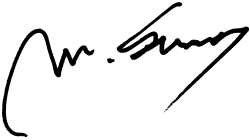Sensing as five senses of machine
1. Sensors and sensing
In preparation for writing the preface to this special issue in OMRON TECHNICS, I read over the preface1) of OMRON TECHNICSÐSerial No. 145 featuring sensing technologies published seventeen years ago. The preface wrote of ãnew value generated by sensing in the ubiquitous network society.ã Interestingly, the content of that preface can readily be applied in the present tense to our situation today, simply by replacing the words ãubiquitous network societyã with ãIoT society.ã This suggests that the technology of sensing is an indispensable presence underpinning social progress in all eras. Although we have used the words ãsensorã and ãsensingã without explanation, the difference between these words is not actually clearly distinguished, and the definitions vary depending on the industry and the standard. However, I always use the words ãsensorã and ãsensingã properly. They can be simply described as follows:
Sensor: |
Element for converting external energy, physical quantity, information, etc. to electric signals by scientific means |
Sensing: |
Process for converting output signals of a sensor as meaningful (= capable of judging ãwhether it suits given purpose or notã) information |
This can be understood as the structure shown in Fig.1.

What kind of relation to society do sensor and sensing technology hereafter continuously have, and how do they evolve? One of the hints for considering this is a vision of the past, the present, and the future of a ãsociety where human and machines coexist.ã
2. Social contribution and its meaning of existence of sensor and sensing technology
OMRON believes that three patterns roughly exist in ãsociety where human and machines coexist.ã The first is a pattern of making a machine substitute for work (that is considered not to be borne by human). Automation in the factory, automatic ticket gate, and many devices (tools) surrounding us, such as smartphones, correspond to this. The second is a pattern of collaboration between human and machines. For example, the driving operation of automobiles and the safety technology for the prevention of collisions are typical examples of the realization of security, safety, and comfort provided by the collaboration between human and machines. And the third is a pattern of expanding human ability from the harmony between human and machines. We consider that this coexisting relation called harmony hereafter increases the opportunity of new implementation in society, differing from the afore-mentioned two patterns where the implementation in society has already been realized. In any one of the patterns mentioned here, it needs to be scarcely said that further technical evolution of machine is required. One of the elements essential for technical evolution is the ãbrainã of the machine. In the past 10 years, AI technology as the brain of the machine evolved dramatically in the technical field of machine learning as pulled by deep learning. It can be said that AI technology is one of technologies that mostly contributed to the evolution of sensing, especially in the past 20 years. However, in order to allow a coexisting relationship between human and machines to be widely implemented in society from substitution to harmony, the evolution of the brain for machines is insufficient. In the first place, a brain cannot exist only as a brain. An essential element together with the brain in the evolution of machines is the embodiment possessed by the machine. The embodiment consists of five senses and actuation. Although the embodiment of machines does not need to be identical to that of human, the five senses of human still correspond to sensor and sensing technology for machines. Sensor and sensing technology will be hereafter increasingly applied to the implementation in society by OMRON as the key technology to the evolution of the coexisting relationship between human and machines. The coexisting relationship between human and machines was so far realized in various ways and is still being realized. The IoT society is also one of them. It is not exaggeration to say that the ãTã in IoT is the sensor and sensing function.
It is often said that in order to make it possible to use AI more versatilely, AI must overcome the barrier of the frame problem,2-4) and the key needed here is also sensing. It is a very interesting story that there exists knowledge that can be acquired only by contacting the environment or contacting the physical world, and the physical and functional limitations of the embodiment are essential for such acquisition of knowledge (although it is rather paradoxical). Boldly speaking, the development of sensor and sensing technology grasps the key for further breakthroughs in the brains for machines (AI technology).
3. Technological prospect for sensor and sensing
How will sensor and sensing technology develop toward the evolution of the coexisting relation between human and machines?
I would like to describe three personal opinions although it is difficult to tell a lot for want of space.
(1) All sensors changing toward image processing
This does not mean that almost all sensors are borne by cameras (imaging sensor). It means that data processing technology that seems as if it processes imaging data will evolve more dramatically not only because the resolution of the sensor improves on spatio-temporal axes but also because the opportunity for collectively handling multiple sensor outputs (that are not necessarily to be the same function) naturally increases. Because of this, the knowledge of image sensing that is also one of core technologies of OMRON will be increasingly utilized multilaterally.
(2) All sensors becoming self-powered
Sensors have the aspect of energy conversion elements that convert physical energy to electric signals. This electric signal can be utilized not only as sensor output but also as its own energy. Furthermore, the evolution of wireless technology will naturally allow the era of wireless power supplies to come in the future. The sensor is considered as the key element of the ãTã in the IoT society and will be increasingly required to be self-sufficient for the implementation in society.
(3) Performance of sensor to be further improved in cooperation with AI
Evolution of the sensor so far was just the evolution of hardware and devices. Hereafter the sensor (embodiment called as sensor) should realize performance (high resolution, high speed, cost reduction, etc.) that will be never realized with the evolution of hardware and devices by deepening cooperation with AI (brain called as AI). Although the S/N (signal-to-noise ratio) sensitivity of humans has limitations, machines can react to even feeble S (signal) exceeding the limit of human sensitivity only if the machine itself can view a large amount of data. This will become the new appearance of dramatic improvements in sensor performance.
Sensor and sensing technologies are widely used for products and solutions by OMRON. It can be said that this reflects the close relationship of OMRON with sensor and sensing technologies. In the autonomous and natural society based on the SINIC theory, the era will come where the sensor and sensing technologies are continuously implemented in society everywhere. In such an era, it is exciting to imagine what kind of role OMRON will play.
4. The Future of Sensing
Sensors and sensing technologies appear many times even in the articles in this volume that do not belong to the special issue on Sensing as the Five Senses of a Machine. This shows how intimately connected sensors and sensing are with OMRONãs technologies as a whole. At the start of this preface I referred to an outlook on sensing technology published in OMRON TECHNICS seventeen years ago, and how it may be applied to our present era. In a like manner, how will this preface look like in the context of the outlook on sensing technology seventeen years later, the era when sensors and sensing technologies are continuously implemented everywhere in the autonomous society defined by the SINIC theory5) ?
- 1ÿ¥
- Outlook for Sensing Technologies in the Ubiquitous Network Society. OMRON TECHNICSÿ¥2003, Vol.43, No.1 (Serial No.145). (in Japanese)
- 2ÿ¥
- McCarthy, J.: Hayes, P. J. ãSome philosophical problems from the standpoint of artificial intelligence.ã Machine Intelligence 1969, Vol. 4, p. 463-502.
- 3ÿ¥
- Dennett, D. ãCognitive Wheels: The Frame Problem of AI.ã The Philosophy of Artificial Intelligence Boden, M. A., ed. Oxford University Press, 1984, p. 147-170.
- 4ÿ¥
- Taniguchi, Tÿ¥Introduction to artificial intelligence by learning through illustrations, Kodansha, 2014. (in Japanese)
- 5ÿ¥
- SINIC Theory for Approaching the Future. OMRON TECHNICS. 1970, Vol.10, No.3 (Serial No.34).


President and CEO
OMRON SINIC X Corporation
















